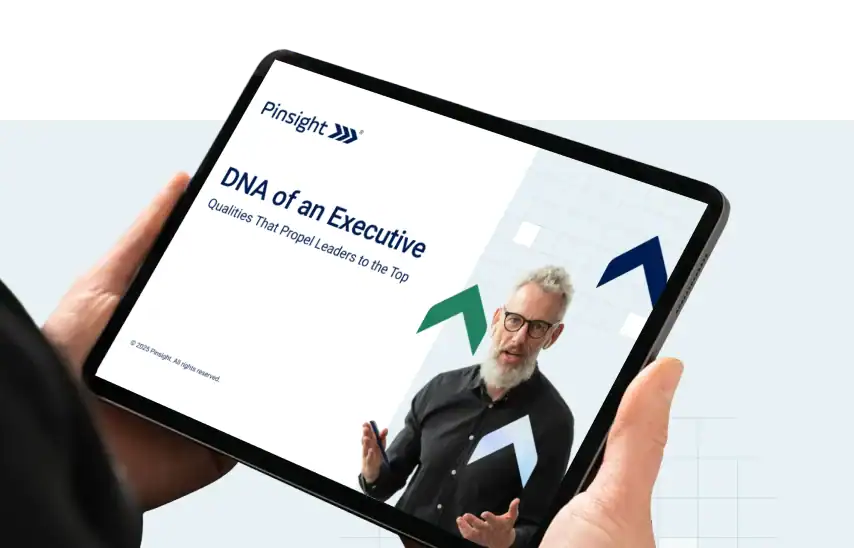Here are the top trends shaping Director & VP+ hiring in 2026, and what they mean for TA leaders who want to modernize and scale executive selection.
1. Skills Over Credentials
For years, senior hiring favored pedigree—big-name schools, marquee companies, impressive titles and tack-records. Today, organizations are pivoting to skills-first hiring. Leadership skills like strategic thinking, leading with empathy, and change management are proving far more predictive of success than resumes and past successes alone.
McKinsey reports that companies adopting a skills-based approach unlock broader talent pools and improve hiring accuracy compared to degree- or title-based methods (McKinsey, 2022). Deloitte echoes this, with 73% of executives agreeing organizations should focus more on skills and experience rather than relying on past credentials (Deloitte, 2025). Read more about how forward-thinking TA leaders are switching from “tell me” to “show me” methods in executive hiring.
- What it means for TA: Assessment strategies must reveal what leaders can do, not just where they’ve been.
2. Leading Through Change in Hybrid, Global Contexts
Director and VP roles increasingly require leading distributed, hybrid, and global teams—often during times of volatility and transformation. Success now depends on agility, resilience, and the ability to drive change while building trust across geographies and contexts.
Gartner’s 2025 survey found that 74% of HR leaders say managers are not adequately equipped to lead change, and 73% report employees are experiencing “change fatigue” (Gartner, 2025). McKinsey adds that leaders today face more simultaneous, high-stakes issues than a decade ago—from digital disruption to geopolitical risk—making adaptability essential (McKinsey, 2023).
- What it means for TA: Look for evidence of adaptability and change leadership. The leaders who thrive are those who can flex across contexts, inspire teams through uncertainty, and deliver results under pressure.
3. Faster, More Efficient Hiring Processes
Top talent expects clarity and speed. Lengthy, ambiguous executive searches signal bureaucracy and risk losing candidates. Enterprises are redesigning assessments to deliver rigor without friction—balancing depth with efficiency. Explore the hurdles organizations face with traditional executive assessments.
SHRM reports that nearly two-thirds of HR leaders cite hiring speed as a top challenge, while only a small number believe their current strategies are delivering effectively at the executive level (SHRM, 2024b). Candidates themselves agree: 78% expect a clear hiring timeline, yet only 26% report having a great experience (TalentMSH, 2024; JobScore, 2024).
- What it means for TA: Every interaction with a senior candidate is a reflection of your brand. Fast, frictionless process wins.
4. Global Consistency with Local Sensitivity
As Director & VP roles become more global in scope, enterprises need consistent standards for leadership selection, while still respecting cultural and regional differences.
In SHRM’s Recruiting Executives: Priorities and Perspectives Report, senior recruiters emphasized the need to modernize executive search processes to compete globally, balancing consistent standards with local adaptation (SHRM, 2023).
- What it means for TA: Relying on different local partners doesn’t scale, and one-size-fits-all assessments can be risky. Globally scalable yet locally adaptable platforms are the future.
5. Data-Informed Hiring Decisions
Organizations are no longer satisfied with gut feel. They’re capturing and analyzing data on leadership hires to see what predicts long-term success, feeding those insights back into future selection.
According to SHRM, executive recruiters rank enhancing recruiting strategy and data-driven decision making among their top priorities (SHRM, 2023). Deloitte reinforces this, noting that only 6% of organizations report making strong progress in aligning leadership outcomes with long-term business value, leaving significant room for improvement (Deloitte, 2025).
- What it means for TA: Leaders want evidence—both to make the right hire now and to strengthen succession pipelines for the future.
What These Trends Mean for You
The message is clear: traditional executive hiring is too slow, too reliant on past successes, and too inconsistent to meet enterprise needs.
TA leaders who adapt—by emphasizing skills, speeding up processes, and leveraging data—will:
- Win top talent before competitors.
- Build stronger credibility with business leaders.
- Scale leadership hiring globally without sacrificing quality.
Final Word
The future of Director & VP+ hiring isn’t more consultants or longer processes. It’s fast, evidence-based, and candidate-friendly.
That’s where modern platforms like Pinsight come in:
- Simulations that reveal real skill and agility under pressure.
- Research-backed insights that align hiring teams.
- Globally scalable and efficient executive assessment process.
- A candidate experience worthy of senior talent—fast, engaging, and brand-enhancing.
With Pinsight, TA leaders can act on these trends today—delivering faster senior hires, stronger brands, and confident decisions.






